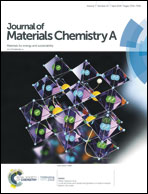Harnessing solvent effects to integrate alkylamine into metal–organic frameworks for exceptionally high CO2 uptake†
Abstract
Humanity's heavy dependence on fossil fuels results in the release of large amounts of carbon dioxide (CO2) into the air. To avoid an irreversible disturbance in the atmosphere and global climate, considerable research efforts have been devoted to reducing CO2 emissions. Employing metal–organic frameworks (MOFs) as solid adsorbents for CO2 is deemed as a promising means to alleviate the problem. Among the MOF family, MIL-101(Cr) is a framework that has ultrahigh porosity, large window openings, and excellent stability, which was anticipated to display very high CO2 capture capacities if functionalized with an alkylamine. However, reported alkylamine modified MIL-101(Cr) materials have not shown impressively high CO2 uptakes as those of other alkylamine functionalized MOFs whose pristine frameworks have comparably high porosities and large windows or channel sizes as MIL-101(Cr). The rare existence of an excellent MIL-101(Cr)-based CO2 adsorbent drove us to investigate the alkylamine tethering process to further unleash the potential of modified MIL-101(Cr) as a CO2 adsorbent. Herein, we report incorporating an alkylamine into MIL-101(Cr) using a solvent (cyclohexane) with very low polarity as the dispersion medium. The resulting modified MOF displayed an enhanced amine loading amount and a significantly increased CO2 capture capacity compared with one prepared in a more polar solvent. The improvement can mainly be attributed to the weaker interaction between the alkylamine and solvent and the concomitant higher chemical potential of the dispersed alkylamine molecules. This drives more alkylamine molecules into the framework from the solution, and leads to MOFs with higher alkylamine loading amounts and higher CO2 uptakes. The generated tris(2-aminoethyl)amine (TAEA) modified MIL-101(Cr) exhibited exceptionally high CO2 uptakes of 4.21 mmol g−1 at 150 mbar and 25 °C, and 4.06 mmol g−1 at 150 mbar and 40 °C in gas sorption measurements. Apart from this, the material also displayed remarkably different breakthrough times for CO2 and N2, and was capable of capturing 4.35 mmol g−1 CO2 at 25 °C or 4.22 mmol g−1 CO2 at 40 °C in dynamic breakthrough experiments with a gas mixture of 15 : 85 CO2/N2 (v/v). This performance reveals the promise of our material to be practically applied as an effective CO2 capture adsorbent.



 Please wait while we load your content...
Please wait while we load your content...